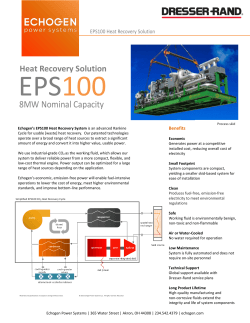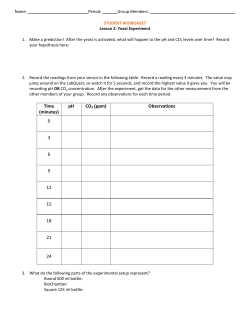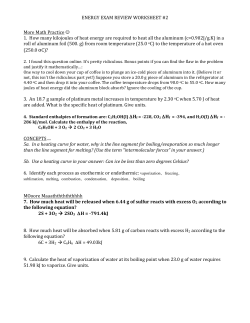
Bonus Assignment & Sign up Sheet
CHEM 1201 sec 5 and 1202 sec 5 & 7- Bonus Assignment Experiment Completion date is by Fri. April 24th The bonus homework assignment (worth 45 pts) is to visit a “preK-12” age range class and perform one of our prepared sets of chemistry-science demonstrations attached with this sheet (at least a 30-45 minute presentation with explanations). You pick a school/class of your choosing You can find a list of all certified public and private schools (with addresses, phone #’s, etc.) in Louisiana on the State Department of Education Web Site. It is up to you to make the arrangements with the teacher about scheduling the demonstration and discuss with them the demonstration you are planning. Schedule your demonstration, ASAP! The maximum # of people I want visiting any one class at a time to perform a set of demonstrations is 3-4! What kind of demos can you do? On the next page is a list & summary of recommended experiments for grades preK-12. Also attached is a sign up sheet, additional Sign - up Sheets to fill out will be posted at my website. At my web site (under Bonus link) and in large envelopes by my office door are the detailed descriptions of the various demonstrations. It also lists some of the chemicals and supplies I will provide and you will need to provide for the demos. Ex: many of the inexpensive accessories to go along with the demo (e.g., glue, plastic pitcher, paper towels, cheap plastic bowls, straws, empty soda cans, etc.). Kit request (check out- 1 week in advance) a kit per experiment: Deadline April 17th noon sharp http://lsusciencedemo.weebly.com/chemdemo-kit-request-form.html (Also, the web-form may have not been updated yet, so disregard anything from the Spring and submit, it goes to the gradstudents and they contact you about picking up the kit materials) You need to fill out the LSU trip insurance form at: https://sites01.lsu.edu/wp/riskmgt/triptravelservice (a link is also posted at www.lsu.edu/sciencedemo. On the Sign-up sheet (ATTACHED): I’ll also need the FULL name of the teacher and FULL address of the school for the class that you will be visiting as soon as you set up a visit. I’ll send the teacher an evaluation form on which they can grade your performance (40 pts maximum from the teacher whose class you visit, 5 pts from me for your essay assignment). You can not do the report unless you were involved in the demonstration. Your final score will be a combination of the report you hand in and the teacher’s evaluation of your demo’s on how good a job you did explaining the science presented in their classroom. Turn in the sign up sheet a week in advance of the experiment. Deadline April 17th noon sharp Give the students a little chalk talk/explanation. Try to speak to their level. Ask them what do they think will happen when…Don’t worry about going over their heads a few times, it’s expected (your in college) and impress them. Report-Aside from performing the demo, EACH person needs to write a 1-2 page, no less than, (12pt font; 1.0” margins, double spaced) report on your classroom experiences. Include a cover page with your name, class/section & Demo: student/teacher response, your impressions, what would you do different, etc. I recommend using your camera phone and take some photos of you working with the students in the class. And insert your pictures of you into the 1-2 page body. Grade K-? General Topic/Demonstrations The Atmosphere: Liquid Nitrogen (LN2), Liquid Oxygen (LO2), Solid CO2 (dry ice), & Water Vapor This experiment involves using LN2 to let the students “see” the major components in the air around us. LN 2 has a temperature of 196ºC and freezing and shattering a flower is always impressive. Pouring LN 2 into an empty soda can causes a thin layer of liquid oxygen to form on the outside and drip off. CO 2 is one of the things we exhale and solid CO2 can be dropped in a container of water to make a “witches brew” effect. Having the students blow air into the LN2 causes water vapor to condense out making “clouds”. K-3 Polymer Fun: Disappearing Styrofoam and Starch When Styrofoam is added to acetone (a common organic solvent) it very rapidly dissolves, making it look like it is disappearing. Starch-based packing “peanuts”, on the other hand, will not dissolve in acetone, but do readily dissolve in water. Environmental consequences of these two properties will be discussed with the class. The melted plastic can be recovered from the acetone to make hard solid styrofoam plastic (thus illustrating recycling). K-? Silly Putty: Synthesizing a Polymer Adding Elmers School glue (or generic brand School Glue) to a water/borax solution causes a chemical reaction between the glue molecules (polyvinylacetate) and the borax molecules (Na2B4O7 •10H2O) to produce a highly flexible, cross-linked polymer. This is similar to silly putty (real silly putty is a polymer based on organosiloxy groups and will not dry out like this material). A hands-on experiment that all students in the class will do. 3-? Acids & Bases NaHCO3 and vinegar will be used to shoot a cork out of a bottle demonstrating that some acid-base reactions generate gases like CO2. Students in the class will participate in a voice-activated chemical reaction. Students will remove a stopper and speak into a flask containing base and an indicator that will change color once enough CO2 is introduced from the student’s breath. Further color changes from basic to acidic conditions will be shown using a basic solution, universal indicator and solid CO2. Reactions of metals and acid will be shown with Mg and Sprite. 4-? Energy: Electricity, Heat & Light (1202 only) The properties of electricity will be discussed and demonstrated with a Tesla coil and a simple generator allowing the students to turn work into electricity. Chemical reactions to make electricity, heat and light will also be performed. The ability to convert one form of energy into another will be discussed. 5-? Light Reactions: Chemiluminesence, Flame Test, Burning Mg/CO2 Various light producing reactions will be demonstrated including chemiluminesence, inorganic flame tests, burning Mg, and finally, burning Mg in dry ice (solid CO2). Chemical aspects of these will be discussed. 6-12 Kinetics, Equilibrium & Catalysis (1202 only) The rates of chemical reactions as a function of temperature will be discussed via the use of light sticks at 3 different temperatures and the H2/O2 balloon explosion. The concept of activation barriers to chemical reactions will thus be introduced. The catalytic decomposition of H 2O2 and oscillating Iodine reaction will also be performed along with the chemical principles involved. Also see the link for experiment details and Vids at: http://lsusciencedemo.weebly.com/chemdemo-lesson-plans--videos.html For the The Atmoshere –to reserve the LN2 & dry ice see Mr. Benn at 133 choppin to make your reservations for the dewers. We have 10 dewers & 1500 students involved in ChemDemo so don’t wait until the last second to reserve these things. So you have to use this sheet 2 times: Deadline 4/17 noon sharp 1. Submit Kit Request 1 week in advance: http://lsusciencedemo.weebly.com/chemdemo-kit-request-form.html 2. Hand this sheet into me, so I can send the evaluation to the teacher Bonus Assignment Sign-up Sheet –Deadline 4/17 Check Off Your Class: CHEM 1201 sec 5____ CHEM 1202 sec 5 ____ CHEM 1202 sec 7 ____ Hand in one per group! Please print CLEARLY!!! Name(s) ___________________________________________________________ Demonstration: ____________________________________________________ __________________________________________________________________ Teacher whose class you are visiting: __________________________________ (first and last name!!) Teachers Email:______________________________________ (No gmail, yahoo or Hotmail etc, teachers email must be from school email address) Grade: K 1 2 3 4 5 6 7 8 9 10 11 12 School to be visited: _________________________________________________ Street Address of School: ____________________________________________ City: _____________________ State: ___________ Zip Code: ___________ School Phone #: _____________________ FAX#: _____________________ Date of Visit : _________________ Experiment Deadline 4/24/2015
© Copyright 2025

















